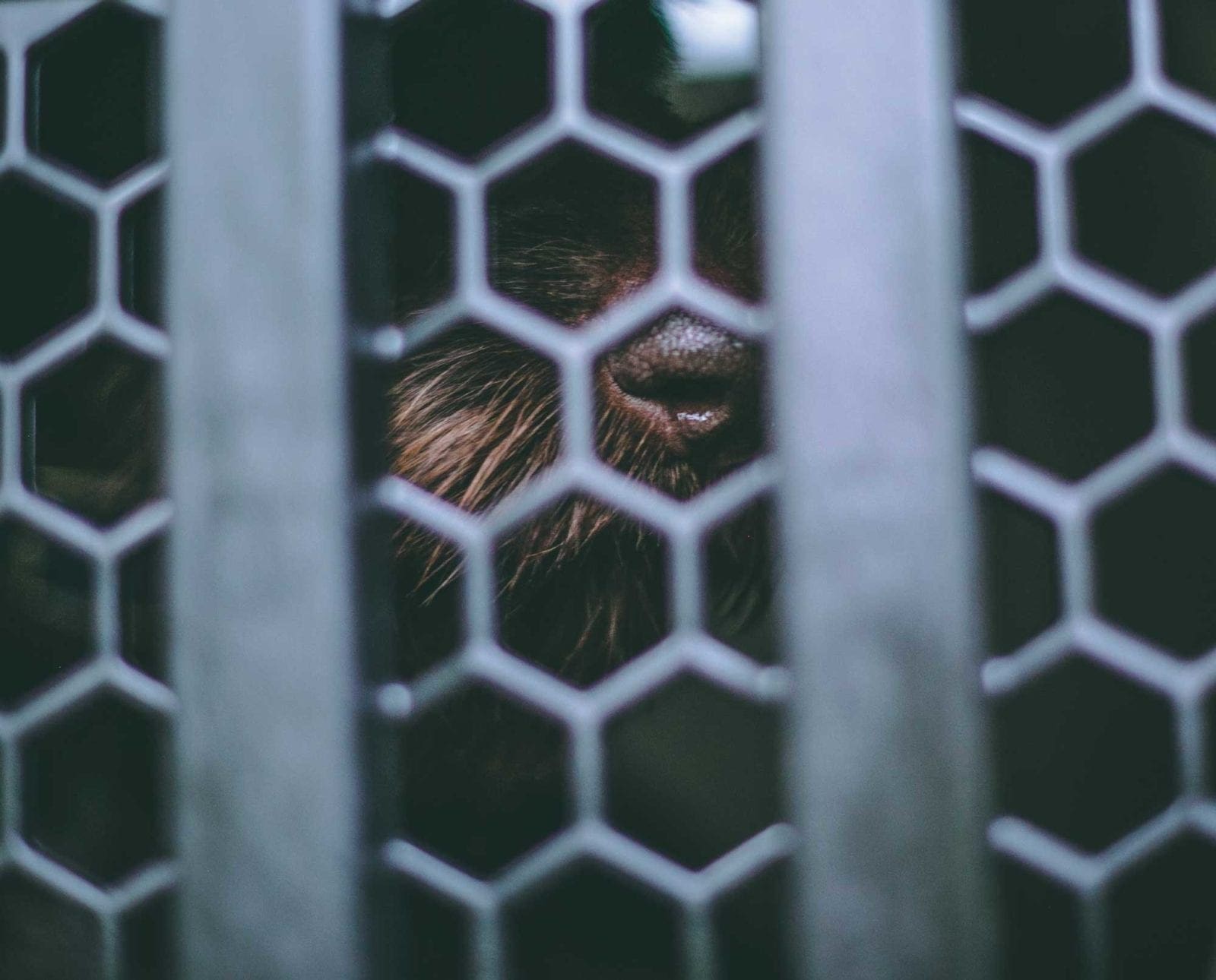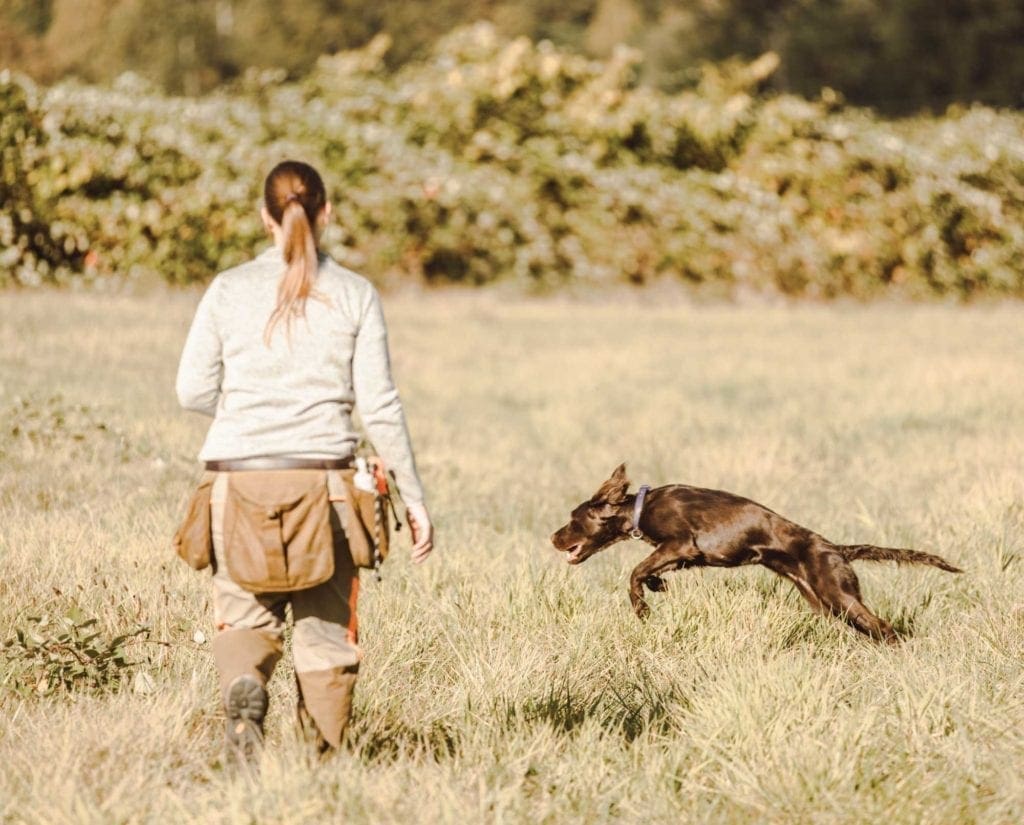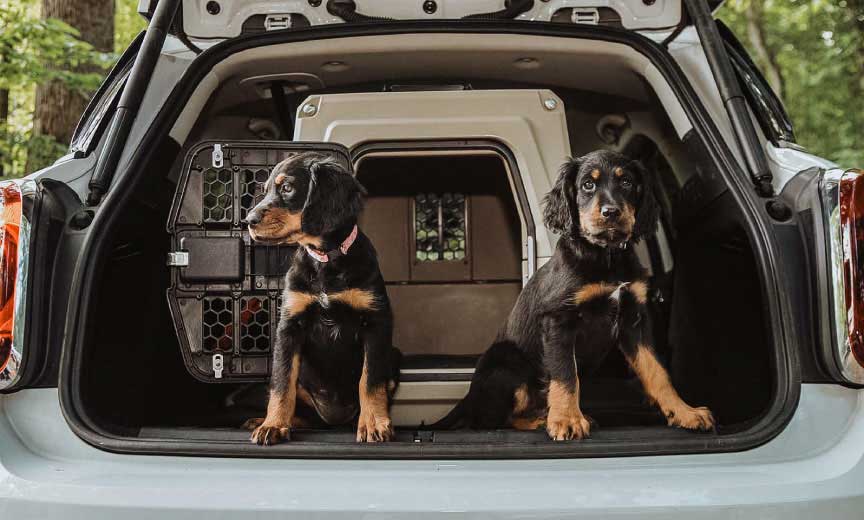
Jennifer Wapenski is the Director of Operations and Managing Partner…
Learning the process, equipment, and troubleshooting of crate training a dog
It was a late stop in a hotel room for a quick sleep before continuing the road trip the next morning. Arms loaded with bags and dog gear, the executive decision was made to leave the kennel in the car. “She’ll be fine, it’s late, and we’re all tired anyway.” Famous last words.
And so began the longest night ever spent in a hotel room. The poor Deutsch Langhaar pup, used to the comfort and security of her crate, had never spent a night “out” on the floor. Without the familiar enclosed space, she spent a restless night on high alert. Every mosquito that flew down the hallway was cause for a bark alarm. Each distant car door was surely worth growling about. Finally, at 2am, we reached a point of desperation and did the unthinkable: she was scooped up into the bed to just get some peace and quiet. The pup stretched out to impossible dimensions for a small dog and soon fell asleep in her newfound security. The humans, regrettably, did not.
With this experience still etched in my memory, I caught up with Gunner Kennels Ambassador and pro trainer Kaitlynd Wilson to talk about the importance of crate training young puppies. Kaitlynd has been training advanced obedience topics and hunting skills for several years, but stresses the importance of setting a good foundation of crate training from an early age.

Why you should crate train a dog?
“Crate training is more than just teaching your dog to go in a box on a command. It’s a big part of the puppy’s development, whether you’re house training, preparing for travel, or just teaching the puppy to be calm,” Kaitlynd says. Since dogs are naturally den-dwelling creatures, the crate simulates a den by offering a safe and secure place for a dog to relax. Puppies who are taught that the crate is their space will naturally learn to seek it out as their quiet place.
This den mentality also extends to house training. By keeping an unsupervised pup in its crate instead of wandering the house, the puppy will quickly learn the concept of waiting to go outside, since it will naturally avoid going in its den. This isn’t to say you can simply lock your pup up until it is house trained, but the concept of a den space goes a long way toward teaching this important subject.
Finally, crate training is essential for the safety of your dog throughout its lifetime. At home, being crated when left alone will keep her out of destructive trouble and possibly prevent the ingestion of something harmful. On the road, a durable crate is critical for safety in the unfortunate event of an accident by keeping the dog safely restrained. When you reach your destination, the crate becomes a portable “safe place” to help the pup relax in unfamiliar places.

Choosing the right kennel size
Selecting the correct kennel size is an important part of the process and will set you up for easier success. An appropriately sized kennel is safer, more comfortable, and more effective for house-training a puppy.
The kennel should be just large enough to allow the dog to stand up, turn around, and sit comfortably. Remember that this is meant to simulate a den, not a bedroom. Dogs don’t think of space in the same way we do, so don’t assume bigger is better. In fact, for transport, bigger is definitely not safer in the event of an accident or sudden maneuver.
Puppies make the question of kennel size a challenging one, since they don’t stay small for very long. Kaitlynd is often asked whether a smaller kennel such as the Gunner G1 Small is required for puppy training, or if you can start with an Intermediate or Large size for the puppy to grow into.
“You can use any size kennel to teach the concept of going in and laying down, but if you’re traveling or house-training, it’s really important to have an appropriate puppy-sized kennel,” she says. If the kennel is too large during house training, the puppy may use part of the crate as a toilet area, which works against your best efforts to teach the puppy to wait until he’s outside.
To be most efficient at training and safest while traveling, the same general rules of sizing a crate for an adult dog should be applied to puppy crates. It’s also a good idea to discuss crate sizes with your veterinarian, especially if you have travel plans with your pup.
Getting started with crate training
Regardless of how you approach kennel training with a puppy, there is one unbreakable rule: always keep it positive.
“It’s really important that the puppy always associates the crate with a positive experience, or else you’ll hurt your ability to create that calm place,” Kaitlynd recommends.
Begin crate training from the first day the pup arrives at home. Put the kennel in a central location and leave the door open. Encourage the pup to enter and praise him enthusiastically when he does. Don’t shut him in at first, but allow him to check it out and get used to entering and exiting. Be consistent in praising his good behavior.
Once he’s comfortable with going in and out, you can begin to close the door briefly. Continue with the generous praise whenever the pup is in the crate and behaving calmly. At this point you can begin to introduce a command word of your choice and start to associate it with entering the crate.
Keep these sessions short and fun. Puppies have short attention spans and you’ll want to be sure to always end on a positive note. It’s better to err on the side of ending the session too soon than to risk over-pressuring a young pup.
Graduating towards independence
Once the pup gets the concept of entering the crate, you can start latching the door and leaving his sight. At this point, it’s an exercise in reading your dog: you’ll have to determine if the whining is truly a young pup’s insecurity or if it’s a loud demand to be let out. Start by ignoring the crying to see if the puppy gives up and calms down. If it seems like the puppy is truly scared of being left alone, you might pass by his field of view and reassure him that everything is ok and you’re still in the vicinity.
Kaitlynd advises that above all, you must remain patient and controlled when dealing with the pup at this stage. “Make sure you never open the door of the crate when the puppy isn’t being calm and quiet, or else you’ve just taught him that he can be released with enough whining and crying – which is a hard thing to undo.”
When the puppy has calmed down and is sitting quietly in the crate, return to open the door and let him out. Once again, be generous with the praise. You’re rewarding the calm behavior and demonstrating that tantrums don’t result in his freedom.
Soon the pup will see the crate as his space where he can go to take a nap or just relax. This is a huge achievement because you can now transport this special space anywhere you need to go, throughout the life of the dog. The permanent association of the crate with calm behavior is crucial for safe and sane travel.
Final thoughts
As dog training goes, crate training hardly makes the list of fun or exciting training subjects. It’s not as thrilling as seeing your pup’s first point or as entertaining as retrieving. However, crate training provides a strong foundation for shaping your dog’s future as a calm, balanced, well-behaved companion – which is ultimately what we all want most out of our dogs. That, and a good night’s sleep.
Jennifer Wapenski is the Director of Operations and Managing Partner at Project Upland Media Group. She has a lifelong passion for the outdoors, dogs, and wildlife; as an adult, she discovered that upland bird and waterfowl hunting were natural extensions of these interests. What started as initial curiosity soon escalated into a life-changing pursuit of conservation, advocacy, and education. Jennifer serves in a variety of roles such as the Breed Warden for the Deutsch Langhaar—Gruppe Nordamerika breed club, on the board of the Minority Outdoor Alliance, and on an advisory committee for the Washington Department of Fish and Wildlife.





I enjoy reading your conversational style. I can hear your voice in my head as I read. Glad to see your interest in pursuing hobbies outside of work.
Hi Susan! It’s great to hear from you – hope you are well!
My Brit pup loves her Gunner Crate. She travels well in it and sleeps soundly there every night.
I’m hard of hearing so over the last 4 labradors I have found, for my own peace of mind, I allow my pups and adults to sleep with us. It cost us a “California King” bed to make it work, but at least when someone needs to go in the middle of the night I can feel them antsing around and deal with it. I still crate train my dogs but I wasn’t getting any sleep when we had a pup worrying that it had to go and I wouldn’t hear it. When a pup has to go, they have to go! That said, the crate has many uses and is an important part of safely owning a dog.
Why do I learn everything after I have suffered the consequences. Proper crate training a must for all future puppies.
I’m going through this now and this pup is not as easy as the last (or at least what I remember) it’s been tough getting them not to scream once the door is locked. Great points about gradually Introducing but what about the first night, or week? Once you bring the pup home at some point that evening they’re going to have to get in and closed in for a while. We’ve just been letting him cry it out for 30-45min. He takes a break for two hours and starts again on repeat. If nothing else he’s at least persistent. Any tips for helping with being in the crate at night those first days / week? Thanks!